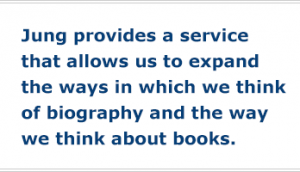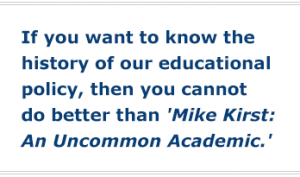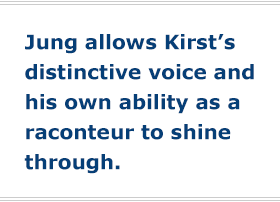
BOOK REVIEW
MICHAEL KIRST: An Uncommon Academic
by Richard K. Jung
Book review by: Daniel McMahon
Daniel McMahon's book reviews and essays have appeared in The Washington Post, Education Week, Utopian Studies, and elsewhere.
Dr. Richard K. Jung has provided 2 significant services in his fine biography of Mike Kirst, professor and policy maker, reformer and sage, optimist and realist. To know Kirst is to get a tour through educational policy at the federal, state, and local levels from the 1960s to the present which will help the reader understand the competing claims of academics and politicians—and to appreciate both roles. A second, and nearly as important service that Jung provides is to expand the ways in which we think of biography and the way we think about books. Since Mike Kirst is still living and there are a great many people who know (and love) him, Jung is able to get them to talk about projects and people and Kirst’s character. In the digital version of the book, these scrupulously edited interviews are hyper-linked so one can listen to them and/or read the transcription with Jung’s helpful commentary.
 Though some time is spent on Kirst’s upbringing and his schooling, this is really an intellectual biography and the biography of ideas about educational policy told through the life of a man who stood with Lyndon Johnson and was a primary architect of the federal government’s policy about education. That Kirst went on to a distinguished academic career at Stanford with numerous publications and that he worked closely with Jerry Brown when Brown was mayor and governor (twice), allows us to see the way that Kirst both developed ideas and allowed those ideas to be influenced by the practice of politics. This is what Jung helpfully calls about Kirst “the humble approach”. Humility is deeply embedded in Kirst’s character which makes him a life-long learner whose work continues even now in his 80s.
Though some time is spent on Kirst’s upbringing and his schooling, this is really an intellectual biography and the biography of ideas about educational policy told through the life of a man who stood with Lyndon Johnson and was a primary architect of the federal government’s policy about education. That Kirst went on to a distinguished academic career at Stanford with numerous publications and that he worked closely with Jerry Brown when Brown was mayor and governor (twice), allows us to see the way that Kirst both developed ideas and allowed those ideas to be influenced by the practice of politics. This is what Jung helpfully calls about Kirst “the humble approach”. Humility is deeply embedded in Kirst’s character which makes him a life-long learner whose work continues even now in his 80s.
Though Kirst is foremost an expert on public schools his devotion to education is in a sense broadly religious despite not practicing any particular faith, except in public education. One might note that his devotion to having policy and practice bubble up from the individual classroom is a version of the practice in Catholic Social Teaching of the principle of “subsidiarity” a deep belief of Jerry Brown’s from his seminary days which springs from a theological premise that most complex issues should be addressed at the closest level to the problem. Indeed, Kirst often is noted especially in his later years saying a version of “what really matters…is improving classroom instruction” or that “local control” is critical to changing schools. Kirst also has a strong affinity, perhaps again influenced by Jerry Brown, for the great Jewish philosopher Martin Buber and seems guided by Buber’s great insight that “all life is meeting.” Kirst can also be seen practicing what is often called “the preferential option for the poor.” His work on equality and equity in funding schools is as inspirational as anything you can find in modern discussions of education.
 There are several through-lines to Kirst’s now 6-decade career and Jung skillfully weaves them together as he hopscotches across time. Kirst comes to education policy not through education but through economics, politics, an internship in Washington DC, and the defeat of his political patrons. This constellation of events led to his move to Stanford University which he believed to be temporary at the time and an appointment in education and business—even though he had never taken an education course. Jung notes that Dean James of Stanford was particularly interested in Kirst because of his unique experiences in federal and state education policy and particularly the politics of school finance reform.
There are several through-lines to Kirst’s now 6-decade career and Jung skillfully weaves them together as he hopscotches across time. Kirst comes to education policy not through education but through economics, politics, an internship in Washington DC, and the defeat of his political patrons. This constellation of events led to his move to Stanford University which he believed to be temporary at the time and an appointment in education and business—even though he had never taken an education course. Jung notes that Dean James of Stanford was particularly interested in Kirst because of his unique experiences in federal and state education policy and particularly the politics of school finance reform.
Oftentimes particular insights come when different disciplines or disciplinary methods are adopted—and Mike Kirst is noted by everyone who knows him as a boundary crosser, a bridge builder, and a man with “a foot in the academic world and a foot in the policy world” in the words of Chester Finn. Jung notes that Kirst himself was drawn to interdisciplinary study from his earliest days at Dartmouth and then at Harvard. He quotes Kirst as saying: “I wanted to do the degree in political economy which would be called public policy today. And I was called in for a session. They [his dissertation advisers] said, ‘You know when you combine disciplines like this, you’re never going to be able to teach in college because they want one or the other.’” But Kirst recognized that specialization can, at an extreme, preclude the ability to talk to others, to get things done, to engage in “meeting.”
Part of Kirst’s genius, as Jung identifies it, is to find the apt metaphor to describe how he thinks about education policy. For example, Kirst chooses the example of education policy as a “marble cake [as opposed to a three-layer cake].” This metaphor recognizes that the federal, state, and local levels are not separate, but they are distinct. Still, each spill into the other and that interweaving, that interpenetration, should be embraced and honored.
 Because Kirst is interdisciplinary by nature and practice, he often is able to occupy and clarify what we might think of as liminal spaces—spaces between more easily recognizable areas. Kirst himself calls this “working the seam” between different sectors in education. He is, perhaps, one of the first people to think of education K-16 (as opposed to K-12) as an integrated field.
Because Kirst is interdisciplinary by nature and practice, he often is able to occupy and clarify what we might think of as liminal spaces—spaces between more easily recognizable areas. Kirst himself calls this “working the seam” between different sectors in education. He is, perhaps, one of the first people to think of education K-16 (as opposed to K-12) as an integrated field.
In addition to extensive interviews with luminaries such as Jerry Brown, Linda Darling Hammond, Chester Finn, and others, Jung allows Kirst’s distinctive voice and his own ability as a raconteur to shine through in several extended quotations. One, about Doris Kearns, is particularly funny, revealing, and self-deprecatory. Kirst’s later years have him studying education policy around the globe and looking always for connections, overlaps, ideas, complementarity.
Kirst’s grounding faith in teachers is a bracing antidote in these fractious times. He is relentless in his pursuit of providing equal and equitable resources for students and teachers. And he understands at a profoundly deep level that policy is implemented at the most granular level and that what is needed is a commitment to “teachers teaching teachers.” Of course, this means you have to trust teachers.
A couple of minor quibbles: because Jung provides the transcription of the quotations there are times when reading his commentary as he teases out the implications will strike some readers as repetitive—for others that repetition will help solidify the observations. On occasion, the conversational style that Jung adopts can sound too redolent of the oral sources he is necessarily engaged with. So, you will sometimes have him write, “let’s check out” some particular person or issue. As I indicated, these are minor cavils to an important text on educational policy.
If you want to know the history of our educational policy and you are looking for optimism in the face of harangues about teachers and curriculum, about CRT and “wokeness”, about book banning and tip lines to report teachers, about legitimate concerns between parental rights and the demand by some parents to order the school to teach not for the civic education required for a democracy but for their own personal values, then you cannot do better than spend some time with Michael Kirst: An Uncommon Academic. “All life is meeting,” says Buber—I implore you, meet Mike Kirst.
* Daniel McMahon's book reviews and essays have appeared in The Washington Post, Education Week, Utopian Studies, and elsewhere.
